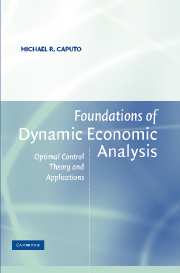Book contents
- Frontmatter
- Contents
- Foreword by Eugene Silberberg
- Preface
- 1 Essential Elements of Continuous Time Dynamic Optimization
- 2 Necessary Conditions for a Simplified Control Problem
- 3 Concavity and Sufficiency in Optimal Control Problems
- 4 The Maximum Principle and Economic Interpretations
- 5 Linear Optimal Control Problems
- 6 Necessary and Sufficient Conditions for a General Class of Control Problems
- 7 Necessary and Sufficient Conditions for Isoperimetric Problems
- 8 Economic Characterization of Reciprocal Isoperimetric Problems
- 9 The Dynamic Envelope Theorem and Economic Interpretations
- 10 The Dynamic Envelope Theorem and Transversality Conditions
- 11 Comparative Dynamics via Envelope Methods
- 12 Discounting, Current Values, and Time Consistency
- 13 Local Stability and Phase Portraits of Autonomous Differential Equations
- 14 Necessary and Sufficient Conditions for Infinite Horizon Control Problems
- 15 The Neoclassical Optimal Economic Growth Model
- 16 A Dynamic Limit Pricing Model of the Firm
- 17 The Adjustment Cost Model of the Firm
- 18 Qualitative Properties of Infinite Horizon Optimal Control Problems with One State Variable and One Control Variable
- 19 Dynamic Programming and the Hamilton-Jacobi-Bellman Equation
- 20 Intertemporal Duality in the Adjustment Cost Model of the Firm
- Index
- References
20 - Intertemporal Duality in the Adjustment Cost Model of the Firm
Published online by Cambridge University Press: 05 June 2012
- Frontmatter
- Contents
- Foreword by Eugene Silberberg
- Preface
- 1 Essential Elements of Continuous Time Dynamic Optimization
- 2 Necessary Conditions for a Simplified Control Problem
- 3 Concavity and Sufficiency in Optimal Control Problems
- 4 The Maximum Principle and Economic Interpretations
- 5 Linear Optimal Control Problems
- 6 Necessary and Sufficient Conditions for a General Class of Control Problems
- 7 Necessary and Sufficient Conditions for Isoperimetric Problems
- 8 Economic Characterization of Reciprocal Isoperimetric Problems
- 9 The Dynamic Envelope Theorem and Economic Interpretations
- 10 The Dynamic Envelope Theorem and Transversality Conditions
- 11 Comparative Dynamics via Envelope Methods
- 12 Discounting, Current Values, and Time Consistency
- 13 Local Stability and Phase Portraits of Autonomous Differential Equations
- 14 Necessary and Sufficient Conditions for Infinite Horizon Control Problems
- 15 The Neoclassical Optimal Economic Growth Model
- 16 A Dynamic Limit Pricing Model of the Firm
- 17 The Adjustment Cost Model of the Firm
- 18 Qualitative Properties of Infinite Horizon Optimal Control Problems with One State Variable and One Control Variable
- 19 Dynamic Programming and the Hamilton-Jacobi-Bellman Equation
- 20 Intertemporal Duality in the Adjustment Cost Model of the Firm
- Index
- References
Summary
This chapter builds directly on the last in developing a duality for the adjustment cost model of the firm. In particular, the current value form of the H-J-B equation given in Theorem 19.3 will be exploited to develop a method to derive the duality properties of the adjustment cost model of the firm. Moreover, we will establish envelope results that will allow the explicit construction of the feedback or closed-loop forms of the investment demand, variable input demand, and output supply functions, given a functional form for the current value optimal value function with known properties. The importance of such a development is monumental in dynamic economic theory for the reasons well summarized by Epstein (1981, page 82):
In static models, duality is a convenience. Demand functions cannot generally be determined explicitly from the technology but they are defined implicitly by first order conditions which can serve as the basis for estimation, though perhaps requiring complicated simultaneous equations techniques. Explicit solutions for calculus of variations problems are even rarer and the implicit representation of solutions generally involves a second order nonlinear differential equation (system) and non-trivial boundary conditions. The differential equation system can serve as the basis for estimation only if the generally unrealistic assumption is made that the firm does not revise its plans for several periods and continues along the same optimal path. Thus duality is indispensable for empirical work based on functional forms that are too complicated to be derived directly from the technology as explicit solutions of a problem of intertemporal optimization.
- Type
- Chapter
- Information
- Foundations of Dynamic Economic AnalysisOptimal Control Theory and Applications, pp. 537 - 566Publisher: Cambridge University PressPrint publication year: 2005



